
Multidimensional Chromatography
.pdfMultidimensional High Resolution Gas Chromatography |
59 |
products with the correct compositional and combustion characteristics. A typical example of the use of gas chromatography when applied to petrochemical analysis can be found in reference (20), while reviews of such applications are also available in selected issues of the Journal of High Resolution Chromatography (21). What is evident from the many reported applications of two-dimensional GC in the areas of hydrocarbon and related analysis is the accuracy of quantitation when compared to that of GC – MS. Since resolution is achieved by chromatographic means alone, well characterized detectors such as the flame ionization detector (FID) may be used in the place of the less easily quantified mass spectrometric detection (22).
Of considerable commercial interest has been the isolation of various alkylsubstituted polycyclic aromatic compounds where these serve as indicators of the geological history of sedimentary rock samples, highly useful in the exploration for oil reserves. The isolation of alkyl-substituted aromatics, however, is a typical problem to which multidimensional GC may be applied. Large numbers of substituted aromatic isomers exist, and their deconvolution by using mass spectrometry alone is still unclear. The most accurate method to directly quantify individual isomers is therefore to resolve each one chromatographically. Schäfer and Höltkemeir (20) in 1992 presented a two-dimensional method that had sufficient selectivity and resolution to individually isolate 1,4-dimethylnaphthalene from 2,3-dimethylnaphthalene without the use of mass spectrometry. This method effectively used a Deans switch to transfer fractions of crude oil between a primary low-polarity column and a 50 % phenyl/25% cyanopropyl/25% methyl polysiloxane secondary column. Figure 3.4 shows a series of chromatograms obtained from the recombination of heart-cuts made from this primary separation. In this case, while a single column of moderate polarity would have enabled some resolution between the target species, to achieve complete isolation would have required an impractical length of column, and hence analysis time.
The analysis of combustion products presents problems of complexity similar to that of feedstock and raw fuel analysis. A highly complex matrix of aliphatic material often exists (as unburnt fuel in the combustion exhaust), whilst the species of interest, for example, carcinogens or mutagens are often at very low concentrations. A classic example of multidimensional GC is its use in the analysis of flue-cured tobacco essential oil condensate.
The chromatograms reported by Gordon et al. (23) shown in Figure 3.5 illustrate the huge complexity of even small heart-cuts made from the primary separation. Once again, a Deans-type switch was used for sample transfer. For the primary chromatogram, each cut is seen to contain only a handful of peaks, yet when a further secondary separation is performed (based on polarity rather than boiling point) a large numbers of extra species can be isolated. The huge complexity in even the sec- ond-dimension chromatogram required that the second column was temperature programmed, and a two-oven approach was therefore applied. In the case of the tobacco condensate it becomes questionable, even with a second separation with full temperature programming, whether the analytical system has sufficient capacity, and that possibly a higher dimension was required to truly characterize the sample. In this
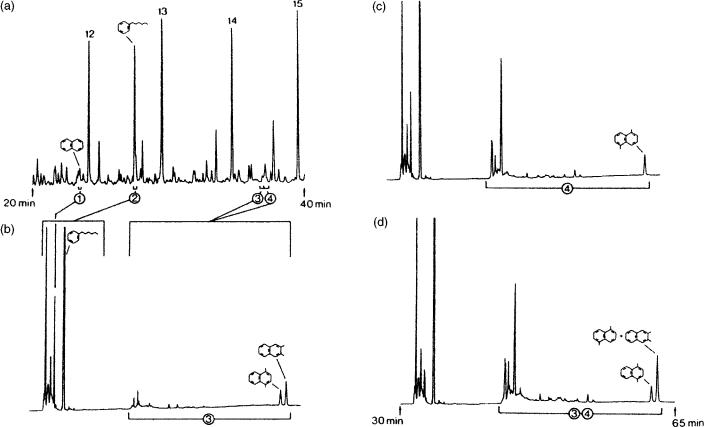
Figure 3.4 Two-dimensional separation of dimethylnaphthalenes in crude oil using a 50 m methyl (95%)/phenyl (5%) polysiloxane primary column and a 50 m methyl (50%)/phenyl (25%)/cyanopropyl (25%) polysiloxane secondary column. The top trace indicates the primary separation monitor, while the following chromatograms indicate individual heart-cut secondary analysis. Reproduced from R.G. Schäfer and J. Höltkemeir, Anal. Chim. Acta, 1992, 260, 107 (20).
60
Chromatography Multidimensional
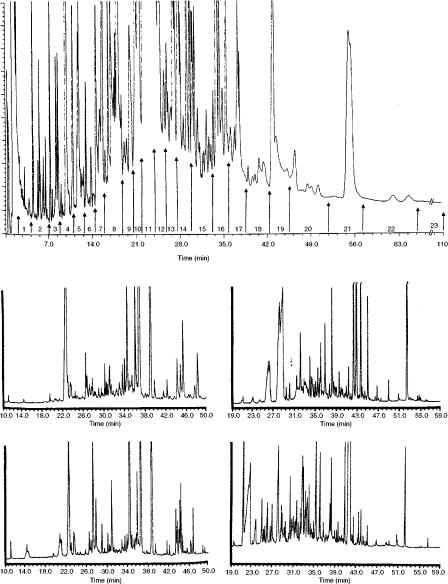
Multidimensional High Resolution Gas Chromatography |
61 |
Figure 3.5 Two-dimensional GC analysis of tobacco essential oil using non-polar primary and polar secondary separations. The top trace indicates the primary separation, with the four resulting heart-cut chromatograms shown below being obtained on the transfer of approximately 1 – 2 min fractions of primary eluent. Reproduced from B.M. Gordon et al. J. Chromatogr. Sci. 1988, 26, 174 (23).
62 |
Multidimensional Chromatography |
example, it was essential that further chemical information was available to produce even group-type classifications in such a mixture, with the addition of a mass spectrometer generally offering the required extra analytical dimension.
A number of environmental applications of two-dimensional GC have arisen as a direct result of the impact of combustion emissions on the environment. The analysis of aromatic species in air may be achieved in a similar manner to petrochemical analysis, although sample pre-concentration becomes essential as the abundances are proportionally lower. Similarly, the measurement of carcinogenic polycyclic aromatic compounds, in particular nitrogen-and oxygen-containing derivatives, is of particular epidemiological interest. The isolation of species in the atmosphere presents similar problems to analysis in fuels, in that a high-concentration aliphatic matrix often masks the target analytes. Multidimensional methods using both GC – GC and LC – GC offer excellent resolution with simple quantitation when using flame ionization detectors, with a number of such applications being covered in Chapter 13. An application worth mentioning from a technical viewpoint, however, is where two-dimensional GC has been used to reduce the analysis time and utilizes isothermal conditions. In particular, a valve-transfer system has been reported for the determination of isoprene and dimethyl sulfide in air, which involves the combination of carrier gas pressure programming with non-polar and PLOT columns (24). Although limited applications have been reported in environmental analysis, GC – GC offers great potential for deconvoluting much of the complexity in these samples, and as well as enabling the use of simple analytical systems which allow high-speed repetitive measurements.
3.3.2 FLAVOURS, FRAGRANCE AND FOOD ANALYSIS METHODOLGIES
In common with the previous application category, this grouping is of great commercial importance to a number of global industries. The determination of species central to the flavour and fragrance industries is highly complex in both chemical complexity and human response. A recurring theme, however, in this type of analysis is that very low concentrations of specific compounds must be isolated from a potentially complex, high-concentration matrix to enable both quantitation and assessment. In this field, assessment may be structural or functional, through the use of a mass spectrometer, or by impact on the human senses through organoleptic assessment, respectively. The use of organoleptic methods (that is, the use of the human nose to ‘detect’ components in a mixture) often highlights problems of resolution in GC separations of complex mixtures. While ideally each strongly detected peak on a chromatogram would have a correlated peak on the detector, this is rarely the case. Often multiple elutions at a given retention time mean that organoleptic assessment merely narrows the field of possible compounds, and very commonly that the nose recognizes components that are not apparent on the detector. Overcoming problems of detector sensitivity inevitably results in preconcentration, elevations in matrix concentrations and a required increase in peak capacity for the separation system.
Multidimensional High Resolution Gas Chromatography |
63 |
Two-dimensional gas chromatography plays an important role in such analysis, in combination with a wide array of sample preparation, and preconcentration techniques and injection devices (25 – 27). While preconcentration prior to the primary column separation is the first step in obtaining sufficient target compounds, ‘oncolumn’ subsequent refocusing at the midpoint between the dimensions can also be used as a method of preconcentration. This can be achieved through either multiple heart-cuts at the same primary column retention time or through zone compression, thus leading to a narrower eluting band (and hence greater mass/unit time) emerging from the second column into the detector.
Sample concentration, and hence enrichment, is certainly a key issue in this area of analysis, since complementary information obtained from NMR or IR spectroscopic detection is often desirable in conjunction with mass spectrometry. Detection methods such as these have far higher concentration thresholds than MS and obtaining adequate quantities of material for detection becomes a significant challenge.
It is worth noting that while a significant number of papers on flavour and fragrance analysis are published each year, this constitutes perhaps only a fraction of the amount of research time spent on this area, and it is likely that the commercial nature of such work has resulted in an under representation in the published literature. Much of the early two-dimensional GC analysis work on flavours and fragrances focused on detecting product deterioration rather than on identifying active fragrance components (28), while work by Nitz et al. (29) demonstrated the use of multidimensional separations in combination with human odour assessment. In this latter study, a two-dimensional GC technique was used to examine wheat grain samples, with pre-fractionation, followed by separation, organoleptic assessment and the final collection of fractions for further analysis. This final collection phase, described as ‘micropreparative,’ yielding sufficient material for either further GC analysis or spectroscopic measurement. The detection of a compound responsible for ‘off-odour’ in this type of product was found to be 2-methyllisoborneol, a trace constituent in what was a highly complex mixture. Its co-elution with higher-concentration species masked identification with single-dimension GC – MS and organoleptic assessment methods.
The analysis of ‘more pleasant’ odours associated with, for example, fruits, plants and extracted essential oils, is also an area that exploits the resolution possible with two-dimensional GC. The analysis of fruit extracts and products by using two-dimen- sional methods was first reported in the mid 1980s and much published work has followed since then (30, 31). Figure 3.6 demonstrates a two dimensional separation of orange oil extract (32), analysed on primary apolar and secondary Carbowax 20M columns. Two-dimensional GC in combination with organoleptic assessment indicated that co-elution of a minor concentration (but odour significant) compound with-myrcene was occurring when the analysis was performed on a single column. The analysis made use of a non-polar primary column in combination with a carbowax secondary column, interfaced by using a Deans switch at the midpoint. The very short cut to the secondary column resulted in no requirement for an intermediate trap, and although the system was operated by using two ovens, the secondary oven was held isothermally.
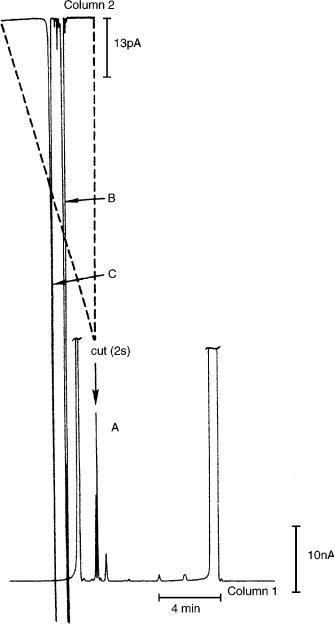
64 |
Multidimensional Chromatography |
Figure 3.6 Two-dimensional gas chromatogram of an orange oil extract, in which a 2 s heart-cut has been made in the region A where -mrycene has eluted on a non-polar column. Secondary analysis on a polar Carbowax 20M column indicated two compounds (marked B and C), both identified as ‘odorous’ by organoleptic assessment. Reproduced from P. A. Rodriguez and C. L. Eddy, J. Chromatogr Sci. 1986, 24, 18 (32).
Multidimensional High Resolution Gas Chromatography |
65 |
It is the determination of volatile organic compounds produced from natural products that requires separation techniques that allow isolation of stereoisomers. The most commonly determined groups are the terpene and sesquiterpene species present in essential oils, which are used as key indicators of biological factors such as the growth season, geographic location, climate, etc. These species are also released directly into the atmosphere by very many plants and trees, and make a substantial contribution to global biogeochemical cycles.
The determination of enantiomers is possible with GC – GC by combination of a nonpolar, basic fractionating primary column used in conjunction with a chiral selective secondary columns. The sophistication of chiral columns has increased significantly since their introduction in the late 1970s (33), with enantiomer-selective two-dimensional separations first being performed in 1983 on amino acids by using Deans switch technology (34). More recent examples related to the food and flavour industry include the work of Mondello et al. (35, 36)and Mosandl et al. (37). Recent analyses reported by Mondello operate without midpoint preconcentration and demonstrates that a high speed of transfer, without band broadening, may be achieved with modern valve interfacing.
The introduction of synthetic materials into natural products, often described as ‘adulteration’, is a common occurrence in food processing. The types of compounds introduced, however, are often chiral in nature, e.g. the addition of terpenes into fruit juices. The degree to which a synthetic terpene has been added to a natural product may be subsequently determined if chiral quantitation of the target species is enabled, since synthetic terpenes are manufactured as racemates. Two-dimensional GC has a long history as the methodology of choice for this particular aspect of organic analysis (38).
Figure 3.7 shows some early examples of this type of analysis (39), illustrating the GC determination of the stereoisomeric composition of lactones in (a) a fruit drink (where the ratio is racemic, and the lactone is added artificially) and (b) a yoghurt, where the non-racemic ratio indicates no adulteration. Technically, this separation was enabled on a short 10 m slightly polar primary column coupled to a chiral selective cyclodextrin secondary column. Both columns were independently temperature controlled and the transfer cut performed by using a Deans switch, with a backflush of the primary column following the heart-cut.
In any form of analysis it is important to determine the integrity of the system and confirm that artefacts are not produced as a by-product of the analytical procedure. This is particularly important in enantiomeric analysis, where problems such as the degradation of lactone and furanon species in transfer lines has been reported (40). As chromatography unions, injectors, splitters, etc. become more stable and greater degrees of deactivation are possible, problems of this kind will hopefully be reduced. Some species, however, such as methyl butenol generated from natural emissions, still remain a problem, undergoing dehydration to yield isoprene on some GC columns.
Isolated problems of racemization, rearrangement or dehydration should not overshadow the fact, however, that the range of species amenable to enantiomeric two-dimensional GC is very wide indeed, including not only terpenes and lactones,
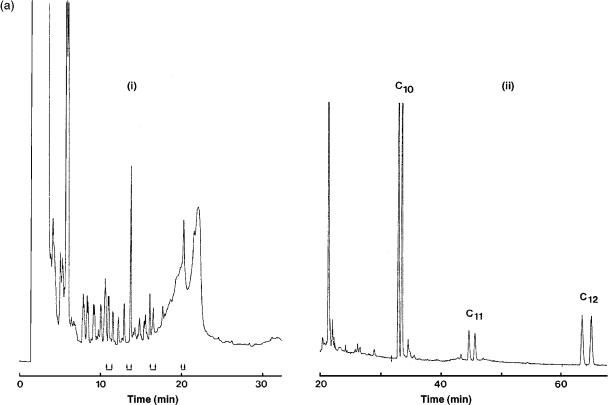
66
Figure 3.7 (a) Chromatograms of (i) the dichloromethane extract of a fruit drink analysed with an apolar primary column, with the heart-cut regions indicated, and (ii) a racemic mixture of -deca-(C10), -undeca-(C11) and -dodeca-(C12) lactones isolated by heart-cut transfer, and separated by using a chiral selective modified cyclodextrin column.
Chromatography Multidimensional
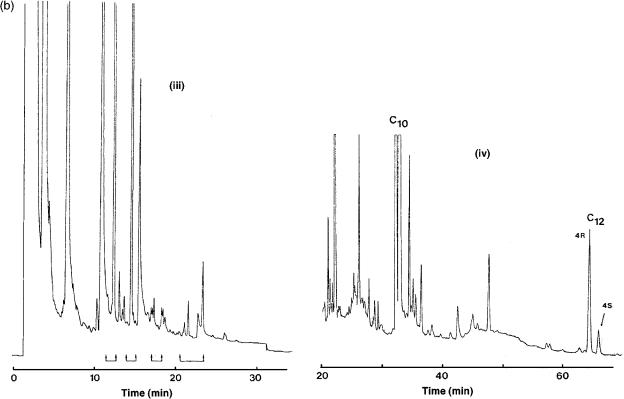
Chromatography Gas Resolution High Multidimensional
Figure 3.7 (continued) (b) Chromatograms of (iii) the dichloromethane extract of strawberry fruit yoghurt analysed with an apolar primary column, with the heart-cut regions indicated, and (iv) a non-racemic mixture of -deca-(C10) and -dodeca-C12 lactones isolated by heart-cut transfer, and separated by using a chiral selective modified cyclodextrin column. Reproduced from A. Mosandl, et al. J. High Resol. Chromatogr. 1989, 12, 532 (39).
67
68 Multidimensional Chromatography
but also esters, alcohols and acids, all of which appear stable under two-dimensional GC conditions (41 – 44).
The study of biochemical natural products has also been aided through the application of two-dimensional GC. In many studies, it has been observed that volatile organic compounds from plants (for example, in fruits) show species-specific distributions in chiral abundances. Observations have shown that related species produce similar compounds, but at differing ratios, and the study of such distributions yields information on speciation and plant genetics. In particular, the determination of hydroxyl fatty acid adducts produced from bacterial processes has been a successful application. In the reported applications, enantiomeric determination of polyhydroxyl alkanoic acids extracted from intracellular regions has been enabled (45).
An obvious extension of enantiomeric two-dimensional GC of natural products is the application of carbon isotope mass spectrometry as the detection process. While the application of isotopic carbon abundance in pharmaceutical and food research has been commonplace for many years, its coupling to enantiomer-selective GC is still little explored. The ability to isotopically discriminate between the species evolved during biological processes can provide valuable checks on the authenticity of the analysis. More specifically, enantiomers from the same origin will have identical 12C/13C ratios. Since isotopic separations are generally not feasible, enantiomeric separation in combination with isotopic mass spectrometry offers a possible analysis route. At present, the sensitivity of 12/13C analysers is significantly less than is normally achieved by using benchtop quadrupole or ion-trap configurations and so detector sensitivity is an important issue. When two-dimensional separations are applied to such a problem, the data obtained are more reliable than those obtained by single-column separations, since background interferences on the chromatogram are very greatly reduced (46, 47).
3.3.2TYPICAL ENVIRONMENTAL CONTAMINANT ANALYSES
While a small number of fuel-derived organic emissions relevant to the environment have been described above, the main environmental application of two-dimensional GC has been in the analysis of halogenated persistent organic pollutants (POPs). This broad classification of pollutants contains species such as polychlorinated biphenyls (PCBs), dioxins, furans, toxaphenes and other persistent organochlorine molecules released via anthropogenic sources. The sources of species such as these are too numerous to list exhaustively but include, (famously) pesticides, and transformer insulator oil. It is their potency to detrimentally affect human health, coupled to long lifetimes in the environment, which has lead to such interest in their analysis. Atmospheric lifetimes are in excess of 100 years, with the major route for degradation being via microbial action in soils. This too, however, is achieved at only very slow rates. The analysis of PCBs is particularly challenging, given a combination of large diversity (over 209 individual biphenyl molecules have been produced in 150 commercial products (48)) and yet a very low abundance in the environment (e.g. pg – ng m 3 in air).
